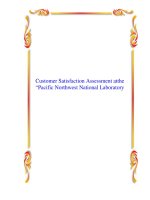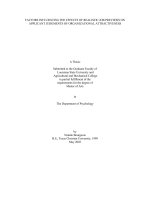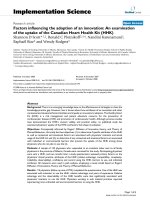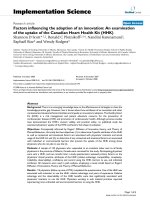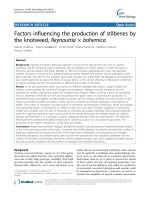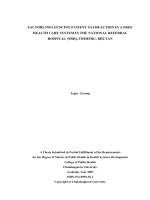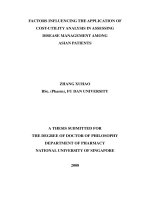Key factors influencing customer satisfaction of jetstar pacific airline in case of delayed of canceled flights
Bạn đang xem bản rút gọn của tài liệu. Xem và tải ngay bản đầy đủ của tài liệu tại đây (1.28 MB, 83 trang )
RESEARCH PROJECT
BMBR 5103
KEY FACTORS INFLUENCING CUSTOMER
SATISFACTION OF
JETSTAR PACIFIC AIRLINE
IN CASE OF DELAYED OR CANCELED
FLIGHTS
STUDENT’S FULL NAME
:
LE MINH THANG
STUDENT ID
:
CGS00018503
INTAKE
:
SEPTEMBER 2014
ADVISOR’S NAME AND TITLE :
ASSOC PROF. DR. PHAN DINH NGUYEN
DECEMBER 2015
Advisor’s assessment
.....................................................................................................................................................................
.....................................................................................................................................................................
.....................................................................................................................................................................
.....................................................................................................................................................................
.....................................................................................................................................................................
.....................................................................................................................................................................
.....................................................................................................................................................................
.....................................................................................................................................................................
.....................................................................................................................................................................
.....................................................................................................................................................................
.....................................................................................................................................................................
.....................................................................................................................................................................
.....................................................................................................................................................................
.....................................................................................................................................................................
.....................................................................................................................................................................
.....................................................................................................................................................................
.....................................................................................................................................................................
.....................................................................................................................................................................
.....................................................................................................................................................................
.....................................................................................................................................................................
.....................................................................................................................................................................
Advisor’s signature
Table of Contents
INTRODUCTION...................................................................................................................................1
1.
Background ...................................................................................................................................1
2.
Purpose of research .......................................................................................................................3
3.
Scope of research ..........................................................................................................................3
4.
Research Statement .......................................................................................................................3
5.
Question of research.....................................................................................................................3
6.
Data collection ..............................................................................................................................4
7. Research Structure ............................................................................................................................4
CHAPTER I: LITERATURE REVIEW ..............................................................................................6
1.1.
Overview of passengers’ service in case of delay or cancellation. ...........................................6
1.2.
Overview of quality of air service in case of delays or cancellations. ......................................8
1.3.
Research Model and Research Methodology ..........................................................................18
CHAPTER II: ANALYZING SERVICE QUALITY OF AIR SERVICE IN CASE OF DELAYS OR
CANCELLATIONS OF FLIGHTS OF JETSTAR PACIFIC AIRLINE……………………………...23
2.1.
Introduction of Jetstar Pacific Airline (JPA) ...........................................................................23
2.1.1.
History and Development ...............................................................................................23
2.1.2.
Business Performance .....................................................................................................24
2.1.3.
Organization ....................................................................................................................25
2.1.4.
Resources ........................................................................................................................25
2.1.5.
Business Activities from 2011-2015 ...............................................................................26
2.2.
Review on delayed and cancelled flights of JPA ....................................................................26
2.2.1.
Review on recent delays and cancellations .....................................................................26
2.2.2.
Review on service quality of air service in case of delays and cancellations .................27
2.2.3.
Evaluation of service quality of air service in case of delays or cancellations ...............29
2.3.
Evaluating air service quality in case of delays and cancellations by using questionnaires. ..32
2.3.1.
Sample .............................................................................................................................32
2.3.2.
Initial analysis .................................................................................................................32
2.3.4.
Summary of research outcome ........................................................................................39
2.3.5.
Conclusion of research ....................................................................................................39
CHAPTER III: SOLUTIONS TO CUSTOMER SATISFACTION IN CASE OF DELAYED OR
CANCELLED FLIGHTS OFJETSTAR PACIFIC AIRLINE…………………………………………43
3.1.
Some solutions aims to enhance customer satisfaction in case of delayed or cancelled flights
of Jetstar Pacific Airline. .....................................................................................................................43
3.2.
Recommendations ...................................................................................................................47
CONCLUSION......................................................................................................................................48
REFERRENCES ...................................................................................................................................49
APPENDIX ............................................................................................................................................50
BUSINESS RESEARCH METHODS 2015
INTRODUCTION
1. Background
Globalization brings both opportunities and challenges to developing
countries especially for Vietnam. Vietnam is promoting its economics
effectively in all sectors, it is now focusing much on air transport sector and
gaining some positive results. Vietnam aviation market is entering an extensive
competition in the context of establishment of new airlines as well as the
penetration of foreign rivals. It is predicted that Vietnam would become the
world’s fastest growing airlines market.
Together with the development of the nation, Vietnam aviation sector
also accomplish some encouraging results, its innovation process is underway
continuously, upgrade equipments with an aim to enhance customer services
and launch new air routes, greatly contribute to state budget. In 2013, Vietnam
aviation market reaped impressive success (up 16.7% in terms of passengers
and 19.6% in terms of cargo against 2012). Simultaneously, cooperation with
other countries has contributed to the success of Vietnam aviation sector in
general and Jetstar Pacific Airline in particular.
Moreover, open policy has created favorable conditions for Vietnamese
business to freely develop, but it also made huge challenges for domestic
airlines with fiercer competition, higher demand of passengers and strictly
follow to international regulations and terms.
Under this situation, to perform all above commitments, Vietnamese
airlines are forced to invest more in human resources, facilities, applications of
Page 1
BUSINESS RESEARCH METHODS 2015
advancements of technologies, international regulations…to manage and
enhance customer services, it has to change management philosophy in terms
of air service to serve passengers, bringing high quality services to passengers
in the coming time.
However, the growing need of air transport would require the
improvement of service quality, and the top priority is customer satisfaction.
Meanwhile, the problems on cancelled and delayed flights always attract much
attention from passengers and airline companies, is has a direct impact on
prestige, competitive capability of airlines. Therefore, it is important for the air
services providers to take drastic measures to control, avoid or reduce the rate
of cancelled and delayed flights in order to prevent loss, satisfy customers and
retain customer loyalty.
As per Jetstar Pacific Airline- one of the best budget airline in Vietnam- it
has developed strongly and attract much attention and sentiment from
passengers. The issue on cancelled and delayed flights has been controlled and
gotten some positive outcomes.
Consequently, to find out more about this research, I would like to
conduct a research on “Key factors influencing customer satisfaction of
Jetstar Pacific Airline in case of delayed or cancelled flights”
Page 2
BUSINESS RESEARCH METHODS 2015
2. Purpose of research
To build and evaluate factors affecting to customers satisfaction when
cancelled or delayed flights occur, figure out the connection between service
quality and customers satisfaction via criteria to find out strengths as well as
weaknesses of customer services. Propose some solutions in order to enhance
customer service in case of cancelled or delayed flights. From that, JPA could
regulate its strategy to be in accordance with set target.
3. Scope of research
The research is conducted at Operation Center of JPA at Tan Son Nhat
International Airport with some service elements which affects passengers’
satisfaction when delayed or cancelled flights take place.
4. Research Statement
JPA is becoming Vietnam’s leading budget airline. To retain the first position,
JPA should focus on improving customer satisfaction and services. In the
coming time, JPA targets these following objectives:
-
Serve the best quality service for passengers in term of pre-flight and
on-board services.
-
Promptly deal with complaints from air travelers.
-
Reduce the cancelled and delayed flight rate.
5. Question of research
To become successful, JPA need to answer these following questions:
i)
How to increase the service quality to compete with other rivals?
ii)
How to handle with customers feedbacks?
iii)
What to be done with the rate of cancelled and delayed flights?
Page 3
BUSINESS RESEARCH METHODS 2015
6. Data collection
a) Primary data:
The primary data is collected by gathering questionnaires. The address of
online questionnaires was sent to respondents with the help of employees in
Tan Son Nhat airport and employees at the head office of JPA. The survey was
also posted in online forums. Furthermore, “person to person” relationship is
utilized to distribute online questionnaires and to gain as many respondents as
possible.
i)
Contacting to employees at Tan Son Nhat airport to get JPA
customer’s
ii)
information such as their email address and Facebook.
Contacting the head office of JPA to deliver questionnaires to
customers.
iii)
Entering forums where Vietnamese share their experience after
their flights. Visiting Facebook of Vietnamese and posting online
questionnaires
iv)
Utilizing
relationship
‘’person
to
person’’
to
send
questionnaires to gain as many respondents as possible
b) Secondary Data:
The secondary data was selected from various literary sources in the
field of marketing and internet resources such as articles, newspapers, online
stories.
7. Research Structure
This research is divided into 3 chapters:
Chapter I : Literature Review.
Page 4
BUSINESS RESEARCH METHODS 2015
Chapter II : Analyzing passengers’ service quality of JPA when delayed or
cancelled flights occur.
Chapter III : Measures to enhance to service quality of JPA.
Page 5
BUSINESS RESEARCH METHODS 2015
CHAPTER I: LITERATURE REVIEW
1.1.
Overview of passengers’ service in case of delay or cancellation.
1.1.1.Service and air service
a)
Service
Nowadays, service becomes a major research factor for different sectors, from
economics to culture, law, administrative to management science.
There are many definitions about service. In general, service is a activity to
satisfy the needs of people. The main characteristic of service is not tangible
like cargo or freight but it directly serves the need of society.
b)
Air service
Definition of air service
Air service comprises all activities with an aim to satisfy the need of
passengers during air transport service utilization process of an airline.
Components of air services.
Air service is divided into 2 types: Ground services and On-Board Services.
However, this research only focuses on Ground Service. Ground service
includes:
Check-in service: includes welcoming passengers at airports, performing
check-in procedures for passengers and luggage service.
Airport service: is defined from the time passengers complete check-in
procedures and wait for boarding. Airport service includes: assisting
passengers at border gate police, customs service, security, inform passengers
the boarding time, giving assistance and hotel accommodations in case of
delay or cancellation. Moreover, it also comprises supply of waiting seats, free
meals, shopping, telephone and free internet access.
Page 6
BUSINESS RESEARCH METHODS 2015
Boarding service: is determined from the time passengers informed to
board to the time stay in their seats. Boarding service mainly focuses on using
buses to board passengers and other services for pregnant, disabled and elderly.
1.1.2.Air service in case of delay or cancellation
a)
Definition of delay and cancellation.
Definition
Delayed flights: are flights which depart behind the planned schedule or
already departed but have to fly back to departure airport.
Cancelled flights: are flights which scheduled but not performed.
Reasons of delay and cancellation
Air traffic control supply: includes the effective co-operation among
airport information, airport devices, objective errors of air traffic controllers,
collision of animals into aircrafts (e.g birds) which is not forecasted will lead
to threat of flights and accordingly the flights have to be cancelled to ensure
safety.
Weather: extremely bad weather conditions like hurricanes, storms etc.
Operational conditions: instability of on-board devices or technical errors
happened at last minute, changes of aircraft status, re-regulation of cargo
loading, lack of aircrafts, which will lead to unpredictable delay or
cancellation.
Elements affecting the capacity of airports that lead to cancellation or
delay: mainly due to overloading infrastructure and lack of apron.
Errors from air service: procedure process exceeds limit time which
pushes aviation staffs must perform loading balance, Stagnation of in-flight
services or long lasting pre-flight process, process of dealing with passengers’
Page 7
BUSINESS RESEARCH METHODS 2015
complaints often spends much time which causes congestion at check-in
counters, wrongdoings of boarding process.
Issues of aviation safety and security: this not only affects aviation sector
but society.
Commercial requirements: transport-related issues to ensure profit when
supply exceeds demand.
Issues of machines, engines: if any problems relating to machines,
engines or any parts of aircrafts detected before departure, it is necessary to
follow safe procedures.
Compulsory landing: the landing is out of prediction of the pilot due to
engine error, system.
b)
Components of air service in case of delay or cancellation
Inform passengers: If there are cases of delays or cancellations, the
airline has responsibility to inform passengers timely in any forms such as:
SMS, emails, sound system, flight information distribution system (FIDS).
Change air routes and ticket refunds: the airline will change air routes
and ticket refunds with an aim to facilitate passengers fly to their destinations
quickly and conveniently.
Providing necessary service: includes meal services, hotels, transport
passengers from airports and hotels, telephone services.
1.2.
Overview of quality of air service in case of delays or cancellations.
1.2.1.Service quality and Model of service quality.
a)
Quality and service quality
Quality
Page 8
BUSINESS RESEARCH METHODS 2015
According to French Standard NF X50-109: “Quality is the potential of
product or service to satisfy the needs of customers”
According to TCVN ISO 8402:1999: “Quality is the combination of
characteristics of an entity which makes this entity satisfy the needs of
customers”
Service Quality
Definition:
According to TCVN ISO 9000:2000: “Service Quality is the combination of
given characteristics of service to satisfy the expect of customers and relevant
parties”
Components of service quality:
According to Prasuraman & partners (1985) believe that any service, the
service quality which is determined by customers has 10 components:
reliability, responsiveness, competence, access, courtesy, communication,
credibility, security, understanding the customers, tangibles. After prolong
research and recheck, scientists have concluded that service quality consist of 5
main components. They are:
-
Reliability: determined by the ability to perform appropriate service and
do right the first time.
-
Responsiveness: determined by the expect and willingness of staffs
which provide timely service for customers.
-
Competence: determined by qualifications and attitude of staffs.
-
Empathy: determined by care to each customer.
-
Tangibles: determined by outlook, customs of staffs and other devices
that serves
b)
customers.
Service Quality Model
Page 9
BUSINESS RESEARCH METHODS 2015
SERVQUAL service quality model
In 1985, Parasuraman and partners proposed a model called “5 gaps” together
with SERVQUAL measurements which were supported by many researchers.
Figure 1: SERVQUAL service model and 5 gaps of service quality
This model measures service quality based on gaps between expectation and
feel of customers for service. They are:
-
Gap 1: Gaps between expectation of customers and perceptions of
organization.
-
Gap 2: the organization transmit either wrongly or impossible to transmit
the expectation of customers and unable to convert it into quality standard.
Page 10
BUSINESS RESEARCH METHODS 2015
-
Gap 3: Service process does not meet service standard. People,
procedures and system do not provide service in line with necessary standard.
-
Gap 4: Promises on TV advertisements do not match with the expected
quality.
-
Gap 5: Perceptions and last experiences do not match with expectation of
service quality.
SERVQUAL measurement consists 2 parts: First, we need to identify the
expectation of customers towards services of company. Second, we identify
feeling of customers towards the performance of service of surveyed company.
SERVPERF model
Model for measuring customer satisfaction of service quality SERVPERF
created by Cronin and Taylor in 1992. The same as SERVQUAL, SERVPERF
still uses 5 criteria and 22 components to measure service quality. However,
this measurement only requires customers to measure their satisfaction towards
services after usage.
1.2.2.Service quality of air service in case of delays or cancellations
a)
Definition, characteristics
Definition
Service quality of air service in case of delays or cancellation is the
satisfactions of passengers towards air services in case of delays or
cancellations.
Characteristics
Service quality of air service in case of delays or cancellations consist all
characteristics of service quality of air service. They are:
Page 11
BUSINESS RESEARCH METHODS 2015
-
Service quality of air service is difficult to measure and evaluate, it is just
evaluated through the feeling of passengers-the direct persons using service.
However, the feeling and satisfaction is determined by many objective factors,
it is unstable, unmeasurable, and changeable.
-
Service quality of air service is exactly evaluated by the satisfaction of
passengers:
+ Service quality depends on satisfaction of direct customers.
+ Customers who directly participate in service process are indispensable part.
They will evaluate correctly and objectively because they pay for the service.
-
Service quality of air service depends on service supply: passengers will
evaluate service through convenience, facility… Hence, they will have
evaluation towards air service though human factors.
-
Service quality depends on each type of passengers: To each different
type of passengers like VIP, children, pregnant…the airlines will offer
different service policy. Accordingly, service quality is not the same as well.
b)
Components of service quality of air service.
Service quality of air service consists of 5 main components as the same as
service quality in general. Specifically, in case of delays or cancellations,
service quality of air service has some following components:
Tangibles
-
Infrastructure: convenience of area for passengers (information counters,
seats in waiting hall) and restaurants, hotels, information board for service
policy.
-
Airport devices: telephone customer service, flight information
distribution system, sound system and other supporting devices.
-
Outlook, customs of staffs: mainly the staffs at airports
Page 12
BUSINESS RESEARCH METHODS 2015
Credibility: is the ability of providing services exactly to passengers
about flight status (delay time, new departure time, reasons of cancel), offer
free meals, suitable compensation…and ability to provide timely service for
passengers.
Responsiveness: is the effectiveness of procedures and dealing with
problems, willingness to help passengers.
Competence: determined by the qualification, knowledge of policy,
handling procedures of delays or cancellations, attitudes of staffs when
communicating with passengers.
Sympathy: staffs must listen, understand and sympathize with the needs
of passengers. From that, staffs must actively propose the best solutions to help
passengers.
After analyzing 5 components affecting service quality of air service in case of
delays or cancellations based on SERVPERF model. I have evaluated and
proposed 4 main components that affect service quality of air service in case of
delays or cancellations. They consist:
Facility: is the convenience of area for passengers and other devices that
support or deliver service to customers.
Policy: is the diversity, transparency and suitability of policy applied by
the airline to deal with delays or cancellations.
Competence: is the qualification and attitude of staffs. This clearly
describes when staffs directly communicate with passengers, deliver services
and collect all necessary information to serve passengers.
Attitude: is the responsibility, calm, courtesy, willingness to help.
Page 13
BUSINESS RESEARCH METHODS 2015
1.2.3.Relation between service quality and customers’ satisfaction
a)
Relation between service quality and customers’ satisfaction.
Service quality and satisfaction are something different but they are quite
correlative in terms of service research (Parasuraman & partners, 1998).
Reason is quality is relative to service, satisfaction is just measured only when
we used the service. If the quality is improved but it does not base on the
demand of customers, then customers will never satisfy the service. Therefore,
when using service, if customers satisfy high quality service, then they will
satisfy the service as well. Whereas, customers do not satisfy the service, then
the dissatisfaction will appear.
b)
Relation between components of service quality of air service and
satisfaction of passengers in case of delays or cancellations.
As for aviation service, it is said that the satisfaction of passengers is extremely
important to image, prestige and success of an airline. In order to enhance the
satisfaction, the airlines first improve their service quality. Diversity,
modernity and suitability of components directly affect satisfaction of
passengers. In case of delays or cancellations, passengers will be dissatisfied
with this late, waiting so long will systematically affect their work, air service
must be best and suitable. Consequently, all components of service quality are
equally important, especially those are human related components (e.g aviation
staffs). Specifically:
Facility
Facility is an indispensable part of a product, it plays an essential role in
boosting labor productivity and enhancing service quality for customers
(Mudrk, et al, 2004). Development of facility management increase perception
Page 14
BUSINESS RESEARCH METHODS 2015
of importance of facility within development of an organization. (Yusoff,
2008; Lepkova, Vilutiene, 2008; Pitt,Tucker,2008). Here, the development of
an organization is measured by the loyalty, satisfaction of customers.
Empirically, customers only satisfy with high quality service. Facility affects
service quality in this case as follows:
-
Convenience of area for passengers: when there are information relating
to delays, cancellations of flights, aviation staffs have responsibility to inform,
explain reasons, as well as propose solutions to deal with passengers’
complaints at information desk. However, the average number of passengers
each flight ranges from 80 to 150 people, with such huge amount of
passengers, the airline should place the information counter in a wide area to
serve many people at a time to avoid congestion. Moreover, there must be
enough seats for passengers to wait for their boarding time.
-
Devices, machines supporting service delivery: the first thing an airline
needs to do in case of delays or cancellations is to inform passengers through
sound system, update flight information on directory board, send SMS or
through customer service switchboard. This is very important because it helps
passengers manage their time, time for pre-flight procedures, eliminate the
waiting time as well as potential risk. According to Katz et al, 1991, he
believed that “when waiting time increases, satisfaction decrease accordingly”.
Besides that, increasing the awareness of passengers on airline policy makes
them easily to adapt to new changes.
Policy
Of components affecting service quality, policy clearly tells about goodwill of
business and has a direct impact on satisfaction as well as purchasing habit
manipulation of customers in the future (Dabholkar et al, 1996). The more
Page 15
BUSINESS RESEARCH METHODS 2015
policy proposed to handle customers’ complaints, the more goodwill the
company has. Today, airline works out basic policy such as flight information,
offer free meals, no charge for overweigh luggage, change air routes or ticket
refunds…However, it is not enough, the determinants of service quality or
satisfaction of customers are the suitability or feasibility of policy. Good policy
does not guarantee good service. For example, the airline compensates
passengers with huge discounts voucher but limited conditions ( it could be the
duration or places applied for the voucher); or policy offering free meals for
passengers when they have to wait so long, but the point is about the hygiene
of food or whether it is tasty or not. Hence, only when passengers feel good
about policy, then they feel good about service.
Competence
Ability to understand, distinguish and adopt to new traits in a multicultural
environment helps aviation staffs build up their communication skills
effectively and flexibly deal with multiple situations from passengers,
especially in aviation environment (Intercultural environment by Fredman and
Antal, 2005). Competence of staffs contributes greatly to interpersonal
communication, job satisfaction and customer satisfaction (Sizoo et al, 2005;
Loyd and Luk, 2011). Existing the positive relation between competence of
staffs and satisfaction of customers (Yu et al, 2001). Staffs of intercultural
competence always gain respect from customers and timely response, ability to
deal with special situations, they can use their own knowledge to predict other
situations (Loyd & Luk, 2011). Well-trained staffs handle problems quickly
and professionally, language competency, intercultural understanding creates
mutual sympathy with customers. Understanding the need of customers will
help staffs flexibly respond to customers. Ability to explain clearly and
Page 16
BUSINESS RESEARCH METHODS 2015
persuasively, passengers will have objective look about problems of airline,
then eliminate difficulty for aviation staffs. Passengers will satisfy both staffs
and services because service is highly appreciated only when customers and
staffs have connections and consensus in transferring service. (Solomon et al,
1985).
Attitude
Responsibility, care each individuals, courtesy communication, persistently
listen to ideas of customers are fundamentals of perfecting service quality (Bob
“Idea Man” Hooey, 2005). Staffs always put themselves in others situations to
better understand passengers. It is obviously for passengers to make
complaints, the first thing staffs should do is to make apology in terms of
delays or cancellations of flights without trying to explain this is out of control
problems. This is also a principle in serving passengers to calm them down,
staffs must be always stay calm, courtesy and nice no matter how badly
passengers react. In this case, passengers are often the persons who scramble
first (complain, question and ask for reasons). Staffs need to listen, do not
interrupt them which make passengers feel they are sympathized and cared.
Willing to help elderly, disabled people, which makes passengers and others
feel good about aviation staffs.
Page 17
BUSINESS RESEARCH METHODS 2015
1.3.
Research Model and Research Methodology
1.3.1.Research Model and Research Hypothesis:
a) Research Model: after researching service quality measurement Servperf
and service perspective makes satisfaction. I suggest research model as
follows:
Competency
Policy
Satisfaction
Attitude
Facility
Figure 2: Model for customers’ satisfaction of air service in case of delays or
cancellations of flights.
Hypothesis Model:
Y= β0 + β1*Competence + β2*Facility + β3*Attitude + β4*Policy.
We have: βi: regression coefficient, i=0,1,2,3,4
b) Research Hypothesis:
Hypothesis
Page 18
BUSINESS RESEARCH METHODS 2015
H1: Competency which is high, Customers’ satisfaction is high accordingly.
H2: Facility which is high, Customers’ satisfaction is high accordingly.
H3: Attitude which is high, Customers’ satisfaction is high accordingly.
H4: Policy which is high, Customers’ satisfaction
satisfaction is high accordingly.
1.3.2. Research Methodology
a)
Research Process
Purpose of
Research
Research
Model
Quanlitative
Research
Quantitative
Research
Official
Measurement
Comtemporary
Measurement
Reliability Testing
and model R2 value
Research
model testing
b)
Research Methodology
Initial Research: conducting direct interview 5 respondents from JPA at
TOC Tan Son Nhat to collect information that passengers care the most within
4 components from research model, set up contemporary measurement.
Afterwards, I hand over questionnaires and find out the responses from
passengers to complete final measurement.
Page 19
BUSINESS RESEARCH METHODS 2015
Measurements of air service in case of delays or cancellations.
Table 1: Measurements of
service quality
Components
Code
Observant
COM1 Language competency.
Know well about the policy and provide
COM2
service right the first time.
Promptly
respond
to
passengers’
COM3
Competency
complaints.
COM4 Flexibly find out the needs of passengers.
COM5 Easy explanation.
COM6 Willing to help.
Information screen displays all flight related
FAC1
info.
FAC2 Good sound system.
Directory of compensation policy placed in
FAC3
an easy to see place.
Facility
FAC4 24/24 telephone.
Clean waiting hall, enough seats for
FAC5
passengers.
FAC6 Wide information desk.
ATT1 Calm and explain clearly.
Give support to elderly, disabled, children
ATT2
and pregnants
Explain in detailed about pre-fight
Attitude
ATT3
procedures.
ATT4 Responsible, flexile and nice staffs.
ATT5 Respect passengers.
Transparent policy.
POL1
Policy
POL2
POL3
POL4
Offer quality meals and drinks.
Easily change air routes and simple ticket
refunds.
Terms and conditions of vouchers eligible
Page 20
BUSINESS RESEARCH METHODS 2015
for most passengers.
Measurement of customers’ satisfaction
Table 2: Measurement of customers’ satisfaction.
Service quality of air service n case of delays or
SAS1
cancellation satisfies passengers.
Choose JPA for flying.
Customers
Satisfaction
SAS2
Refer to a friend.
SAS3
Official Research: is quantitative research through questionnaire. In
questionnaire, it comprises filter session, personal information (gender, age,
education), measurement of service quality includes 21 observant variables and
3 observant variable of satisfaction (li-kert measurement) from 1 (very bad) to
5 (very good).
-
Official research is conducted at TSN airport and by using application
Google Docs. There are no limits in research scale.
-
Data analysis which is chosen in this research is EFA method and
regression analysis. According to Hair and partners (1998), to do EFA, we
need to collect data with at least 5 samples over 1 observant variable. This
model has 24 observant variables, so the sample equals N=24x5=120 samples.
To reach the target, 300 questionnaires have been used. After collecting and
testing, there are 200 complete and eligible questionnaires to be used.
Page 21
